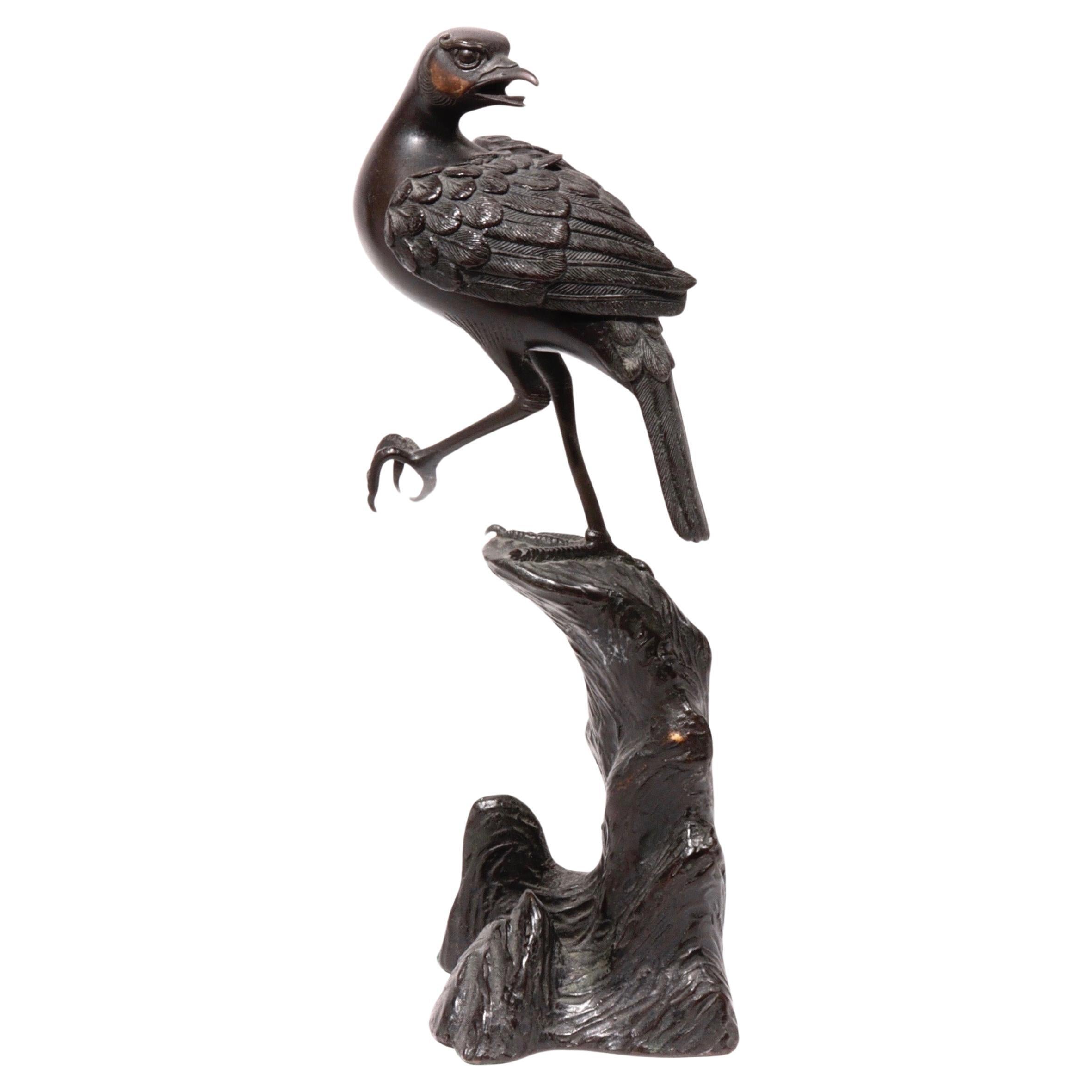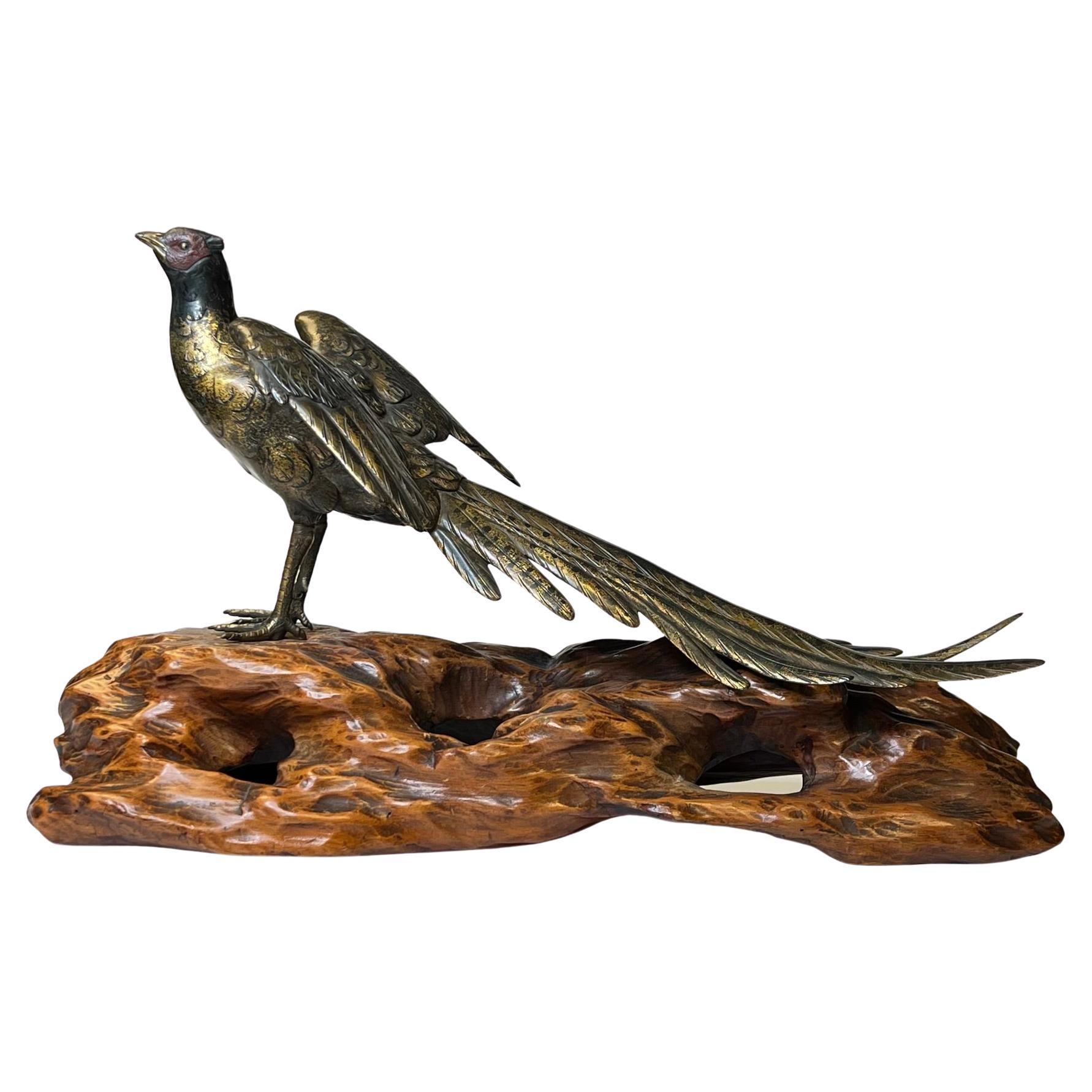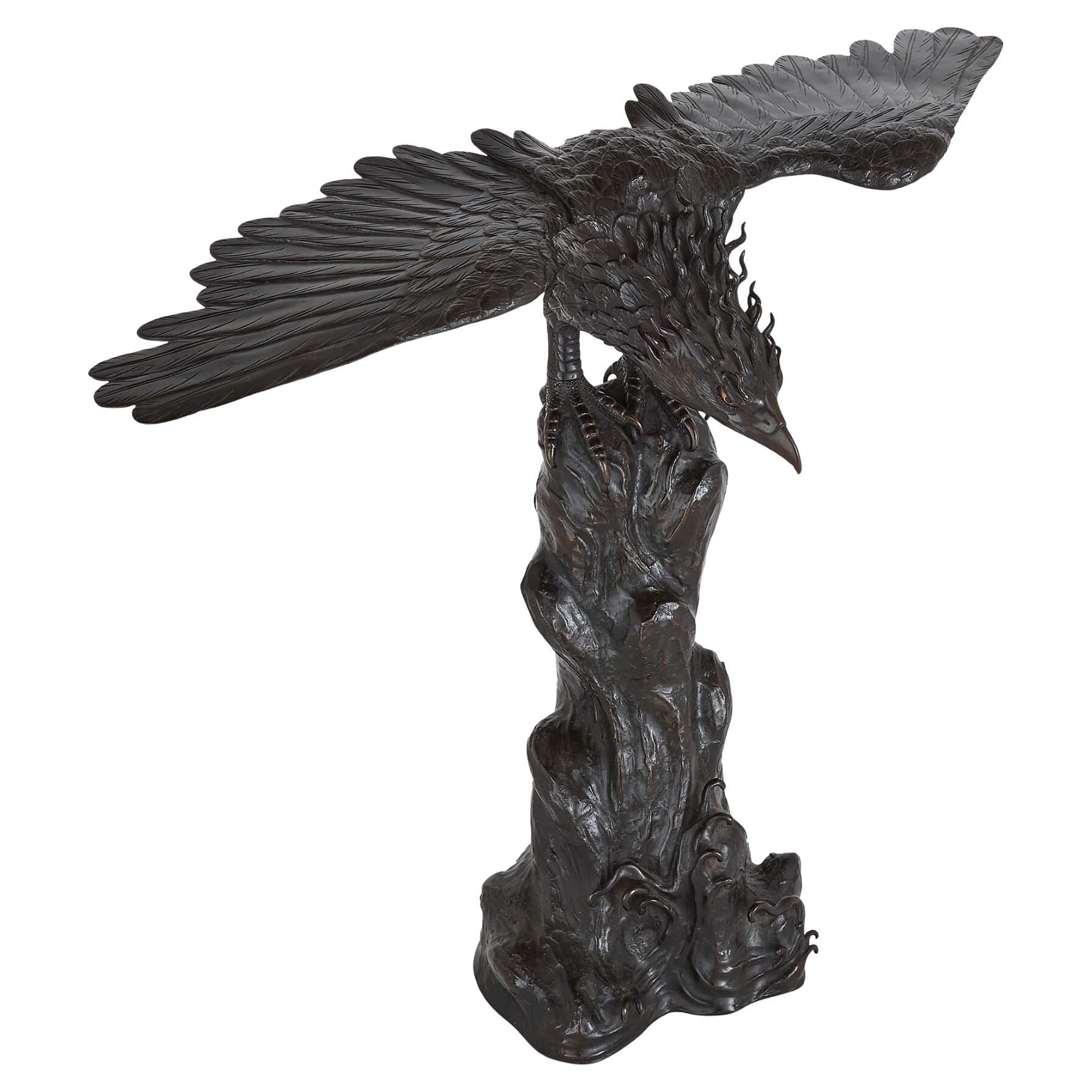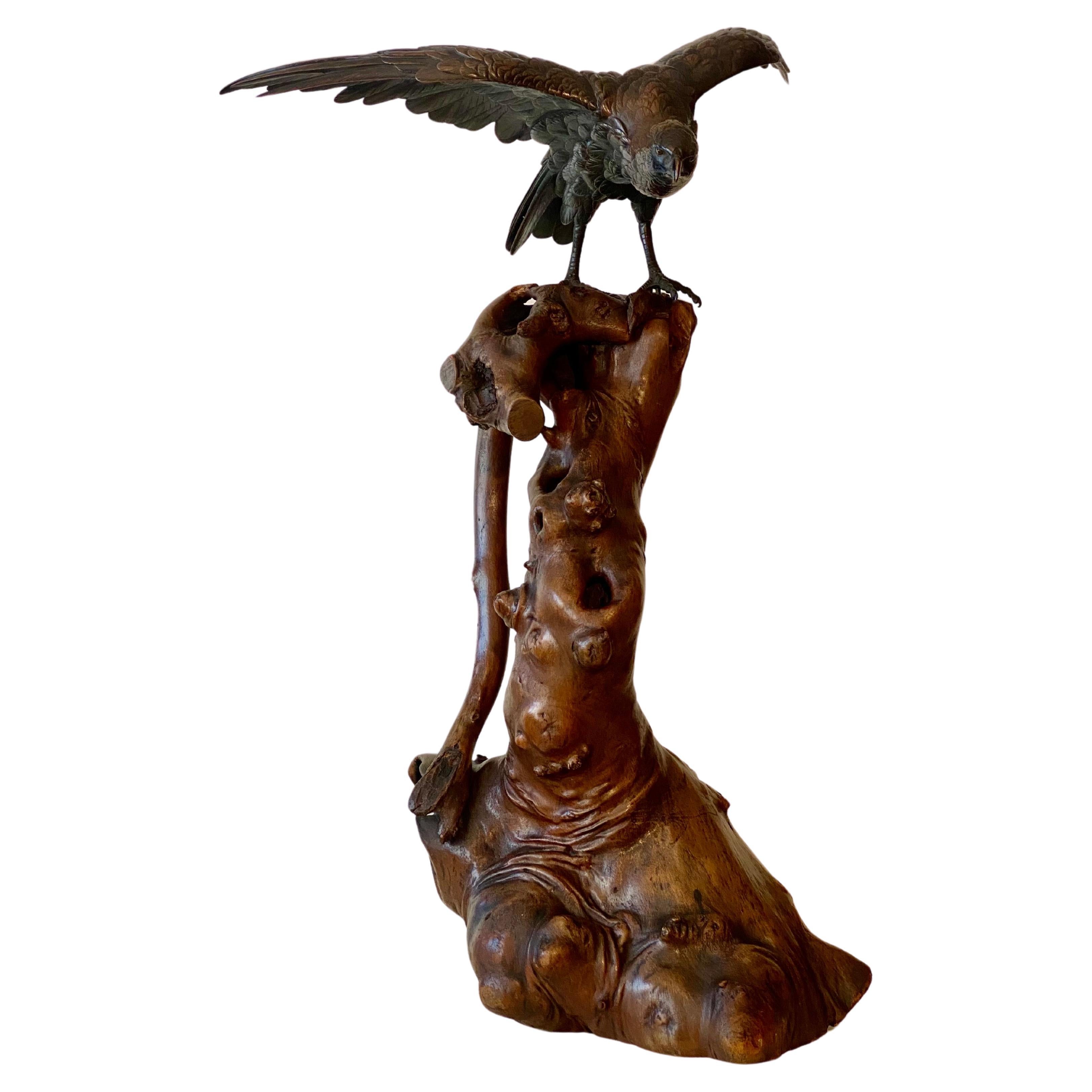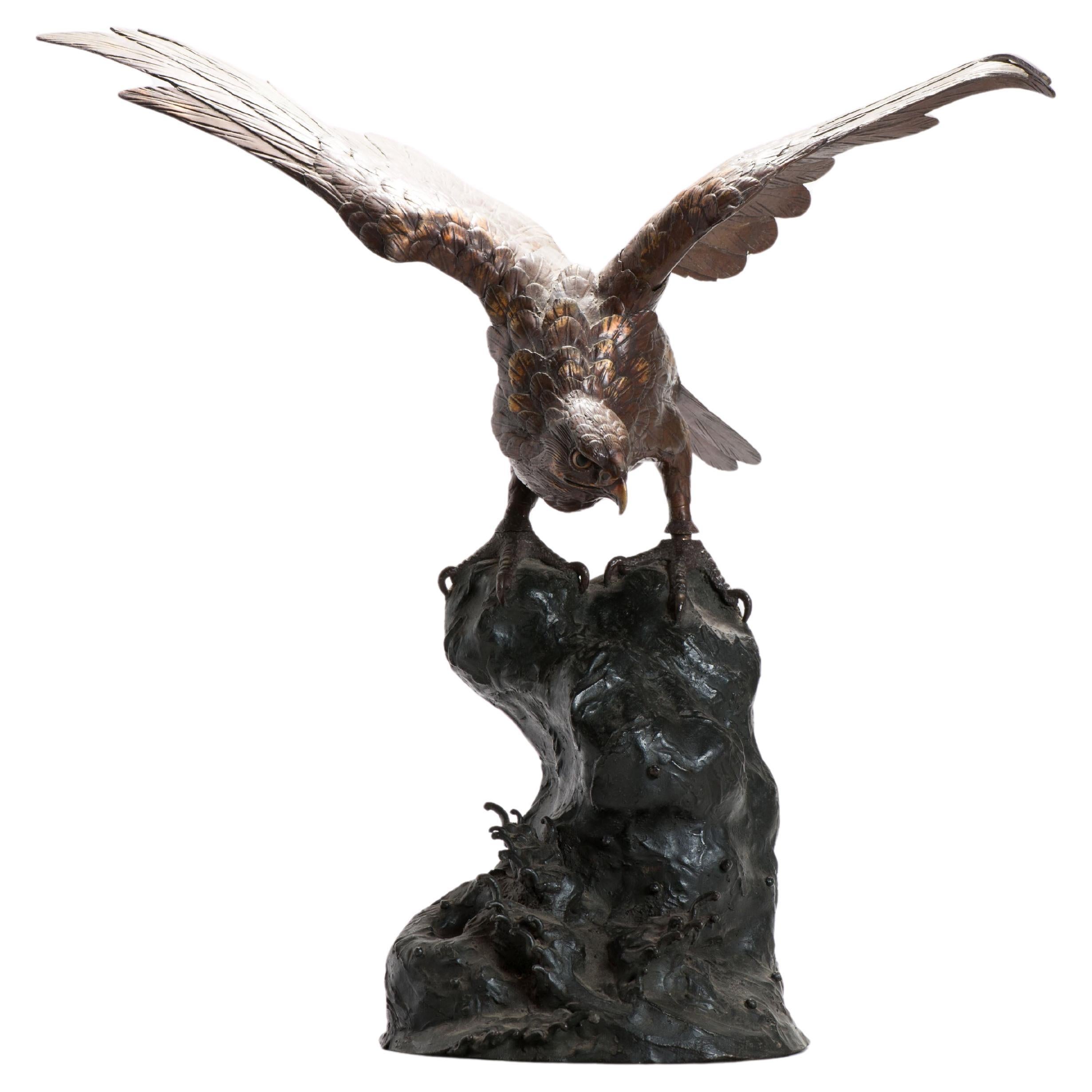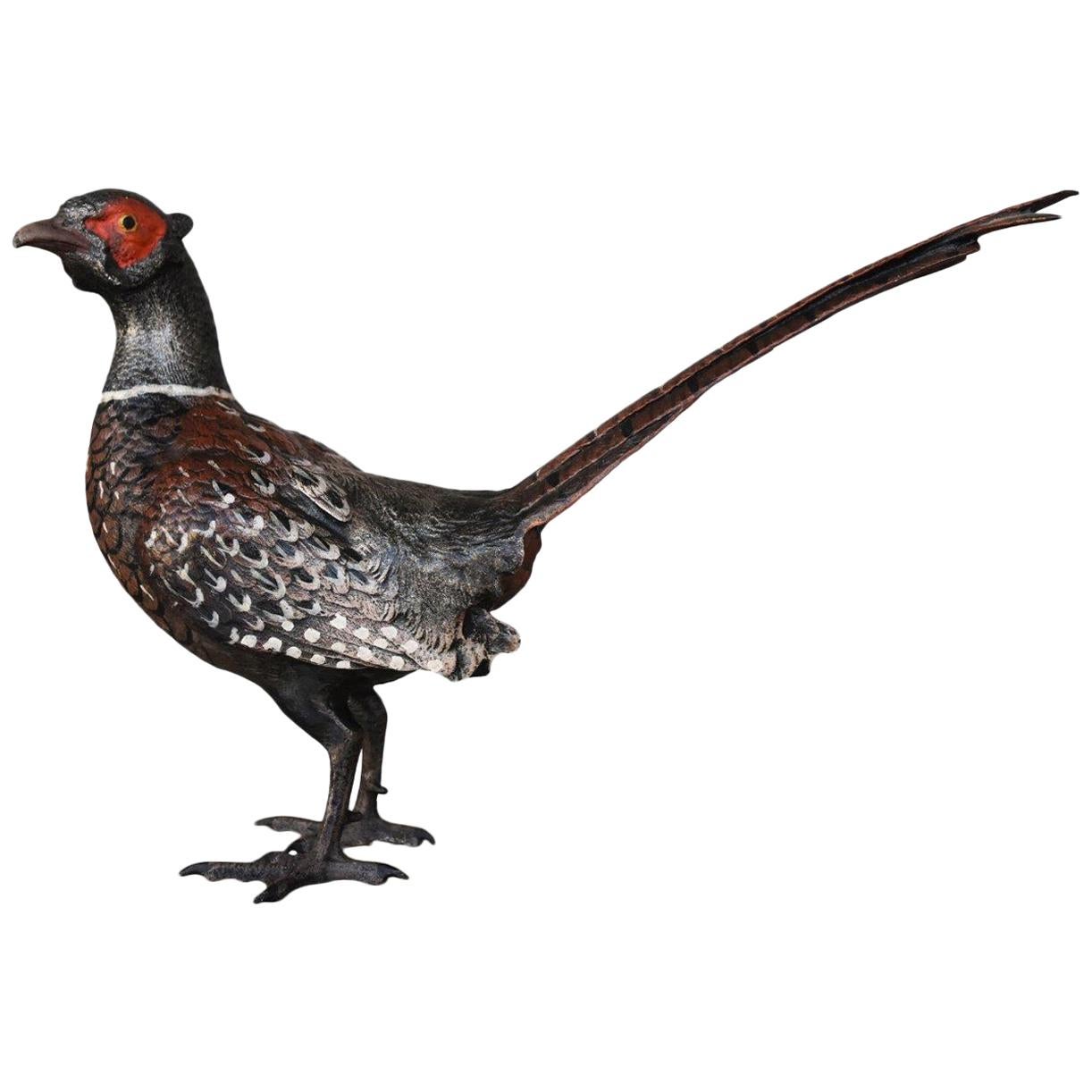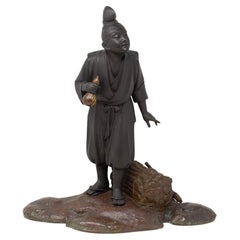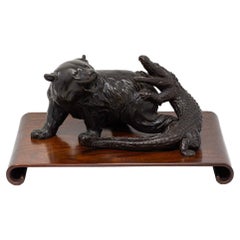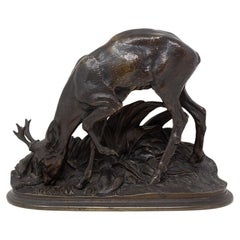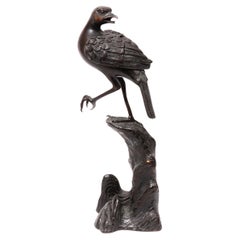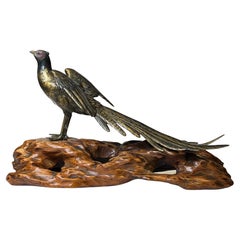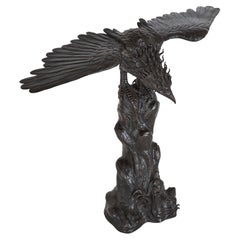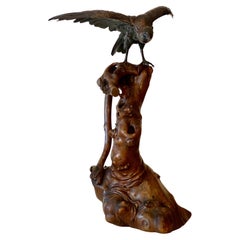Items Similar to Japanese Bronze Pheasant Okimono Genryusai Seiya
Want more images or videos?
Request additional images or videos from the seller
1 of 18
Japanese Bronze Pheasant Okimono Genryusai Seiya
$25,326.06
£18,400
€21,567.77
CA$34,574.88
A$38,463.14
CHF 20,162.86
MX$470,010.13
NOK 256,748.84
SEK 241,693.51
DKK 160,995.20
Shipping
Retrieving quote...The 1stDibs Promise:
Authenticity Guarantee,
Money-Back Guarantee,
24-Hour Cancellation
About the Item
Unusual Casting of a Pheasant in Flight
From our Japanese collection, we are delighted to offer this Japanese bronze okimono of a Pheasant upon a naturalistic root wood base. The Pheasant cast from bronze with gilded feathers standing seconds before taking flight. With an extreme attention to detail Seyia has captured a stunning representation of the male pheasant with intricate detailing from the bill to the claws. Signed under the belly within a square tablet, Genryusai Seiya 源龍斎誠谷造. The Bronze Okimono dates to the Meiji Period (1868-1912) circa 1890.
Genryusai Seiya is one of the most celebrated Japanese bronze artists of the Meiji period. His workshop specialised in export wares of supreme quality, including animals, vases, and human figures. Most commonly Seiya bronzes can be seen as tigers and elephants often in single form or small groups. Renowned for his attention to detail, Seiya manages to encapsulate a natural and realistic look to every figure that has you checking twice to see if it is indeed a sculpture.
Meiji Period was an era of Japanese history that spanned from 1868 to 1912. It was the first half of the Empire of Japan, when the Japanese people began to build a paradigm of a modern, industrialised nation state and emergent great power, influenced by Western countries and aesthetics. As a result of radically different ideas, the changes to Japan were profound and it affected the social structure, politics, economy, military, and foreign relations across the board. The period corresponded to the reign of Emperor Meiji and was preceded by the Keio era and was succeeded by the Taisho era.
Cultural Art during the Meiji Period was of particular interest to the government and they overhauled the art export market which in turn promoted Japanese arts via various world’s fairs, beginning in Vienna at the world fair in 1873. The government heavily funded the fairs and took an active role organising how Japan’s culture was presented to the world including creating a semi-public company named Kiritsu Kosho Kaisha (First Industrial Manufacturing Company). The Kiritsu Kosho Kaisha was used to promote and commercialise exports of Japanese art and established the Hakurankai Jimukyoku (Exhibition Bureau) to maintain quality standards. For the 1876 Centennial International Exhibition in Philadelphia, the Japanese government created a Centennial Office and sent a special envoy to secure space for the 30,000 items that would be displayed. The Imperial Household also took an active interest in arts and crafts, commissioning works by select artists to be given as gifts for foreign dignitaries further emphasising the high quality and importance of Japanese art. Just before the end of the 19th century in 1890, the Teishitsu Gigeiin (Artist to the Imperial Household) system was created to recognise distinguished artists. These artists were selected for their exceptionally high quality wares and talent in their own industry. Over a period of 54 years Seventy artists were appointed, amongst these were ceramicist Makuzu Kozan and cloisonné enamel artist Namikawa Yasuyuki.
Measurements (centimetres) 46cm High x 46cm Wide x 25cm Deep inc. Base
- Creator:Genryusai Seiya (Sculptor)
- Dimensions:Height: 18.1 in (45.98 cm)Width: 18.1 in (45.98 cm)Depth: 9.8 in (24.9 cm)
- Style:Meiji (Of the Period)
- Materials and Techniques:
- Place of Origin:
- Period:
- Date of Manufacture:Circa 1890
- Condition:Wear consistent with age and use.
- Seller Location:Newark, GB
- Reference Number:Seller: PRDDS1stDibs: LU6971237393362
About the Seller
5.0
Gold Seller
Premium sellers maintaining a 4.3+ rating and 24-hour response times
Established in 2019
1stDibs seller since 2022
36 sales on 1stDibs
Typical response time: 3 hours
- ShippingRetrieving quote...Shipping from: Newark, United Kingdom
- Return Policy
Authenticity Guarantee
In the unlikely event there’s an issue with an item’s authenticity, contact us within 1 year for a full refund. DetailsMoney-Back Guarantee
If your item is not as described, is damaged in transit, or does not arrive, contact us within 7 days for a full refund. Details24-Hour Cancellation
You have a 24-hour grace period in which to reconsider your purchase, with no questions asked.Vetted Professional Sellers
Our world-class sellers must adhere to strict standards for service and quality, maintaining the integrity of our listings.Price-Match Guarantee
If you find that a seller listed the same item for a lower price elsewhere, we’ll match it.Trusted Global Delivery
Our best-in-class carrier network provides specialized shipping options worldwide, including custom delivery.More From This Seller
View AllAntique French Bronze Pheasant and Weasel by Jules Moigniez
By Jules Moigniez
Located in Newark, England
Pheasant and Weasel
From our Sculpture collection, we are delighted to offer this French Bronze Pheasant by Jules Moigniez. The French Bronze of good scale cast with a large male Pheasant clambering upon a rocky outcrop startled by a Weasel hiding within the foliage. The Pheasant naturalistically cast with individual feathers visible, sharp claws and spurs above the foot. The Weasel sits hidden in the foliage visible from viewing the French Bronze from the side as it shocks the Pheasant. The French Bronze signed to the front left on a rock face J. Moigniez (Jules Moigniez). The bronze sculpture dates to the late 19th century belle époque period Circa 1870.
Jules Moigniez (1835-1894) was born at Senlis, Oise, just north of Paris, France on the 28 May 1835 the son of a metal gilder. Moigniez studied under Paul Comoléra (1813-1890) a specialist Animalia sculptor. It is clear that Moigniez’s career in Animalia was passed down from his tutors specialism in Animalia and in particular birds. Moigniez father bought a foundry specifically to cast his son’s sculptures. This gave Moigniez a huge advantage compared to other artist as it greatly reduced his costs during manufacturing and increased productivity keeping the process in-house. Moigniez throughout his career became known for this Animalia sculptures...
Category
Antique Late 19th Century French Belle Époque Animal Sculptures
Materials
Bronze
Japanese Bronze Okimono Sculpture by Yamamoto Kozan
Located in Newark, England
YOUNG MAN WOOD CUTTING
From our Japanese collection, we are pleased to offer this Japanese Bronze Okimono by Yamamoto Kozan. The Japanese Bronze Sculpture cast in Bronze with a natu...
Category
Early 20th Century Japanese Meiji Sculptures and Carvings
Materials
Bronze
Japanese Meiji Period Bronze Group Bear & Alligator by Yoshimitsu
Located in Newark, England
The Japanese group comprises of a Bear being attacked by a large alligator. The alligator jumping on the back of the Bear with mouth wide opening showing its razor sharp teeth. The b...
Category
Antique Late 19th Century Japanese Meiji Animal Sculptures
Materials
Bronze
French Roe Deer Bronze Sculpture by Pierre-Jules Mene
By Pierre Jules Mêne
Located in Newark, England
Free international shipping
Signed P. J. Mene
From our Sculpture collection, we are delighted to introduce this Bronze Animalia Sculpture of a R...
Category
Antique Late 19th Century French Belle Époque Animal Sculptures
Materials
Bronze
French Antique Bronze Sculpture by Eutrope Bouret
By Eutrope Bouret
Located in Newark, England
Lady and the Bee
From our Bronze Sculpture collection, we are delighted to offer this beautiful French Bronze Sculpture by Eutrope Bouret. The Sculpture modelled in bronze with a su...
Category
Antique Late 19th Century French Belle Époque Figurative Sculptures
Materials
Bronze
Japanese Meiji Period Damascene Box by Ashizuki with Gold and Silver
Located in Newark, England
INLAID WITH A GOLD AND SILVER DEER
From our Japanese collection we are pleased to offer this Japanese Damascene Box by Ashizuki. The Japanese Box of re...
Category
Antique 19th Century Japanese Meiji Metalwork
Materials
Gold, Silver, Brass, Iron
You May Also Like
Antique Japanese bronze incense burner, in the form of a bird
Located in Point Richmond, CA
Antique Japanese bronze incense burner, in the form of a bird perched on one foot on a tall rocky outcropping, the bird’s head l...
Category
Antique Late 19th Century Japanese Meiji Metalwork
Materials
Bronze
Antique Meiji Japanese Patinated and Gold Speckled Bronze on Wooden Stand
Located in New York, NY
Antique Meiji Japanese Patinated and Gold Speckled Bronze on Original Wooden Stand.
Category
Antique Late 19th Century Japanese Meiji Animal Sculptures
Materials
Bronze
Antique Japanese patinated bronze eagle
Located in London, GB
Antique Japanese patinated bronze eagle
Japanese, c. 1900
Height 54cm, width 67cm, depth 32cm
This fine and naturalistic Meiji period bronze...
Category
Early 20th Century Japanese Meiji Animal Sculptures
Materials
Bronze
Large Antique Japanese Bronze Eagle Root Wood Base Meiji Period Signed Gyoko 36"
By Gyoko
Located in London, GB
Japanese bronze Eagle modelled with its wings outstretched and head lowered,
All the feather work is finely carved with rich brown patination, p...
Category
Antique 1890s Japanese Meiji Sculptures and Carvings
Materials
Bronze
Huge Antique Meiji Japanese Bronze Bird of Prey On a Rock Gold Elements Marked
Located in Amsterdam, Noord Holland
Huge Antique Meiji Japanese Bronze Bird of Prey On a Rock Gold Elements Marked
Condition
Close to perfect condition, just some ware. 40 x 45CM LengthxWidexHeight (including base)
P...
Category
Antique 19th Century Japanese Meiji Ceramics
Materials
Metal, Bronze
$7,941 Sale Price
20% Off
Vienna Bronze Pheasant, circa 1900
By Bergmann Foundry
Located in Marseille, FR
Vienna bronze pheasant, circa 1900.
Category
Early 20th Century Austrian Animal Sculptures
Materials
Bronze
More Ways To Browse
Emperor Japan
Japanese Bronze Sculptures
Antique Pheasants
Claw Bronze
Pheasant Art
Japanese Elephant
Bronze Tiger
Bronze Animal Sculpture Japan
Japanese Tiger
Japanese Meiji Carving
Centennial 1876
Pheasant Sculpture
Signed Bronze Vase Japanese
Japanese Bronze Animals
Japanese Cloisonne Bronze
Elephant Carving
Arts And Crafts Bronze Vase
Meiji Bronze Sculptures
